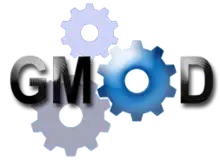Generic Model Organism Database
The Generic Model Organism Database (GMOD) project provides biological research communities with a toolkit of open-source software components for visualizing, annotating, managing, and storing biological data. The GMOD project is funded by the United States National Institutes of Health, National Science Foundation and the USDA Agricultural Research Service.

History
The GMOD project was started in the early 2000s as a collaboration between several model organism databases (MODs) who shared a need to create similar software tools for processing data from sequencing projects. MODs, or organism-specific databases, describe genome and other information about important experimental organisms in the life sciences and capture the large volumes of data and information being generated by modern biology. Rather than each group designing their own software, four major MODs--FlyBase, Saccharomyces Genome Database, Mouse Genome Database, and WormBase—worked together to create applications that provide functionality needed by all MODs, such as software to help manage the data within the MOD, and to help users access and query the data.
The GMOD project works to keep software components interoperable. To this end, many of the tools use a common input/output file format or run off a Chado schema database.
Chado database schema
The Chado[1] schema aims to cover many of the classes of data frequently used by modern biologists, from genetic data to phylogenetic trees to publications to organisms to microarray data to IDs to RNA/protein expression. Chado makes extensive use of controlled vocabularies to type all entities in the database; for example: genes, transcripts, exons, transposable elements, etc., are stored in a feature table, with the type provided by Sequence Ontology. When a new type is added to the Sequence Ontology, the feature table requires no modification, only an update of the data in the database. The same is largely true of analysis data that can be stored in Chado as well.
The existing core modules of Chado are:
- sequence - for sequences/features
- cv - for controlled-vocabs/ontologies
- general - currently just dbxrefs
- organism - taxonomic data
- pub - publication and references
- companalysis - augments sequence module with computational analysis data
- map - non-sequence maps
- genetic - genetic and phenotypic data
- expression - gene expression
- natural diversity - population data
Software
The full list of GMOD software components is found on the GMOD Components page. These components include:
|
|
Participating databases
The following organism databases are contributing to and/or adopting GMOD components for model organism databases.
| ANISEED | AntonosporaDB | Arabidopsis |
| BeeBase | BeetleBase[4] | Bovine genome database (BGD) |
| BioHealthBase | Bovine QTL Viewer | Cattle EST Gene Family Database |
| CGD | CGL | ChromDB |
| Chromosome 7 Annotation Project | CSHLmpd | Database of Genomic Variants |
| DictyBase[5] | DroSpeGe | EcoCyc |
| FlyBase | Fungal Comparative Genomics | Fungal Telomere Browser |
| Gallus Genome Browser | GeneDB | GrainGenes |
| Gramene | HapMap | Human 2q33 |
| Human Genome Segmental Duplication Database | IVDB | MAGI |
| Marine Biological Lab Organism Databases | Mouse Genome Informatics | Non-Human Segmental Duplication Database |
| OMAP | OryGenesDB | Oryza Chromosome 8 |
| Pathway Tools | ParameciumDB[6] | PeanutMap |
| PlantsDB | PlasmoDB | PomBase |
| PseudoCAP | PossumBase | PUMAdb |
| Rat Genome Database | Saccharomyces Genome Database | SGD Lite |
| SmedDB | Sol Genomics Network | Soybase |
| Soybean Gbrowse Database | T1DBase | The Arabidopsis Information Resource |
| TGD | The Genome Institute | The Institute for Genomic Research |
| TIGR Rice Genome Browser | ToxoDB | TriAnnot BAC Viewer |
| VectorBase | wFleaBase[7] | WormBase |
| XanthusBase | Xenbase | |
Related projects
- Bioperl, BioJava, Biopython, BioRuby, etc.
- Ensembl
- Gene Ontology
- DAS
- Genomics Unified Schema
- Manatee: Manual Annotation Tool
- Biocurator.org
- Open Biomedical Ontologies
- Sequence Ontology Project
See also
References
- Christopher J. Mungall; David B. Emmert; The FlyBase Consortium (2007). "A Chado case study: an ontology-based modular schema for representing genome-associated biological information". Bioinformatics. 23 (13): i337–i346. doi:10.1093/bioinformatics/btm189. PMID 17646315.
- Stein LD; Mungall C; Shu S; Caudy M; Mangone M; Day A; Nickerson E; Stajich JE; Harris TW; Arva A; Lewis S. (2002). "The generic genome browser: a building block for a model organism system database". Genome Res. 12 (10): 1599–610. doi:10.1101/gr.403602. PMC 187535. PMID 12368253.
- Afgan, E.; Baker, D.; van den Beek, M.; Blankenberg, D.; Bouvier, D.; Čech, M.; Chilton, J.; Clements, D.; Coraor, N.; Eberhard, C.; Grüning, B.; Guerler, A.; Hillman-Jackson, J.; Von Kuster, G.; Rasche, E.; Soranzo, N.; Turaga, N.; Taylor, J.; Nekrutenko, A.; Goecks, J. (8 July 2016). "The Galaxy platform for accessible, reproducible and collaborative biomedical analyses: 2016 update". Nucleic Acids Research. 44 (W1): W3–W10. doi:10.1093/nar/gkw343. PMC 4987906. PMID 27137889.
- Wang L; Wang S; Li Y; Paradesi MS; Brown SJ. (2007). "BeetleBase: the model organism database for Tribolium castaneum". Nucleic Acids Res. 35 (Database issue): D476–9. doi:10.1093/nar/gkl776. PMC 1669707. PMID 17090595.
- Chisholm RL; Gaudet P; Just EM; Pilcher KE; Fey P; Merchant SN; Kibbe WA. (2006). "dictyBase, the model organism database for Dictyostelium discoideum". Nucleic Acids Res. 34 (Database issue): D423–7. doi:10.1093/nar/gkj090. PMC 1347453. PMID 16381903.
- Arnaiz O; Cain S; Cohen J; Sperling L. (2007). "ParameciumDB: a community resource that integrates the Paramecium tetraurelia genome sequence with genetic data". Nucleic Acids Res. 35 (Database issue): D439–44. doi:10.1093/nar/gkl777. PMC 1669747. PMID 17142227.
- Colbourne JK; Singan VR; Gilbert DG. (2005). "wFleaBase: the Daphnia genome database". BMC Bioinformatics. 6: 45. doi:10.1186/1471-2105-6-45. PMC 555599. PMID 15752432.